Bath is a complex that includes several rooms with different purposes. The requirements for the steam room, washing room and changing room are different. The decoration of the bath is selected in accordance with them.
- General requirements for the characteristics of bath rooms
- The choice of materials for interior decoration of the bath
- What to use in the steam room
- Finishing materials for washing
- Tambour and rest room
- Bath interior decoration
- Warming
- Electrical wiring and lighting
- Ventilation organization
- Washroom finishing
- Bath furniture
General requirements for the characteristics of bath rooms
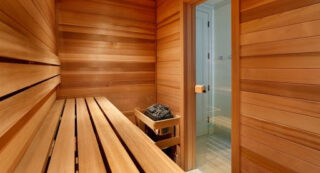
A bath, even a small one, is divided into 4 zones: a treatment room - a steam room or a sauna, a washing room, a recreation area - a dressing room, possibly a swimming pool, a technical one - a toilet, a transit one - a corridor. The latter may be absent.
The bath project can be complemented by a guest room.
Sauna and washroom finishes are not exactly the same. Consider requirements separately.
- Sauna - the air temperature here reaches +110 C, but the humidity is very low. The main requirement for the cladding is temperature resistance and low thermal conductivity, otherwise the surface of walls and shelves will burn human skin.
- Steam room - the temperature rarely exceeds +60 C, the humidity, depending on the type of bath, varies from 80 to 100%. The finish must be resistant to steam, hot water and temperature.
- Washing room - the temperature in the room is not higher than a comfortable 28–30 C, the humidity level is quite high. But it is not supported on purpose, but is only determined by the frequency of taking a shower. It is better to sheathe the washing room with materials that are as resistant to water and high humidity as possible.
The dressing room can be either a real relaxation area - a room with a table and a sofa, or a simple dressing room. There are no special requirements for finishing, but the room should look cozy.
The technical area includes a toilet and additional rooms that increase comfort: a firebox, a storage for bath accessories and appliances, a changing room.
The corridor allows you to enter the dressing room or steam room. You should not neglect this area: a person leaving the steam room into the dressing room takes out moisture and lets steam into the room. A person entering from the street creates a draft and lets in the cold.
The choice of materials for interior decoration of the bath
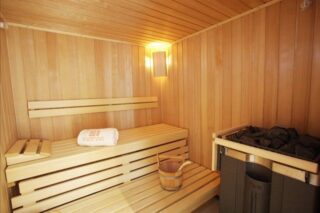
The interior decoration of the bath depends on the nature of the premises. Wood is a universal material. However, the washroom and the sauna require different types of wood.
What to use in the steam room
The steam room is a room with high humidity and a fairly high air temperature. Correct cladding here immediately excludes materials that conduct heat well - stone, metal, plaster. They get too hot and can burn. Of the wood species, those that conduct heat worse are chosen.
Moisture resistance is the second important factor. It is unprofitable to change the finish after 2-3 years of operation.
An important requirement is the tactile factor. The surface of walls, floors, shelves must remain flat, smooth and clean at any temperature and humidity. This excludes conifers.
Suitable wood species:
- Linden is the best option. The tree is not afraid of water and steam, does not heat up strongly at high temperatures, has a delicate pinkish color and a soft, even texture. Linden retains its qualities for a long time, does not rot and is not prone to mold.
- Aspen is resistant to steam and moisture, under their influence it only becomes stronger. However, this only applies to high-quality wood. The latter is less than 1/3 of the total volume.
- Alder is very similar to aspen, more durable and more attractive.
- Cedar is an exception among conifers. The cedar finish is very beautiful and has pronounced antiseptic properties.
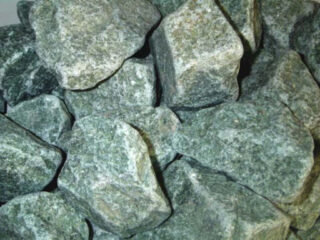
You should not decorate the bath with pine or spruce - the wood contains a lot of resins. Also, such soft breeds - poplar, apple, cherry - are not suitable. They are unstable to water and temperature.
If we are talking about a Russian bath, then you need to choose not only the casing, but also the material for the stove. It is dangerous to splash water on a metal surface: the steam will burn your hands. To get “correct” fine steam, stones with high rates of heat accumulation are used: talcochlorite, for example.
Finishing materials for washing
The lining of the sink is selected in the same way as the finishing of the bathroom in the house: according to the degree of moisture resistance and durability. The choice is traditional.
- Ceramic tiles are a budget, modern and practical material. For the floor, take rough tiles to prevent slipping. For walls, any low-porosity option is used.
- Artificial and natural stone - its custom characteristics are similar to those of ceramics. However, installation is much more difficult than tiling.
- Wood trim is also allowed. Preferred materials that are not afraid of water: aspen, larch.
You can decorate the walls with moisture-resistant or mosaic plaster.
Tambour and rest room
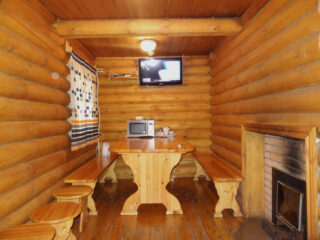
Operating conditions in these premises do not differ from residential ones. Any material is suitable for decoration. It is important to consider the design of the bath complex and the style. If the bathhouse is built of logs, you should not sheathe the walls with clapboard or mask with drywall. This option is suitable for decorating a rest room in a foam block bath.
Bath interior decoration
The cladding of a wooden or brick bath from the inside includes not only the actual finishing. In order for the steam room, sauna and washroom to function correctly, it is required to insulate the walls, waterproof them, and carry out communications.
Warming
The temperature in the steam room and sauna reaches high values. However, it is not profitable to maintain it only by operating the furnace. To maintain the desired temperature and humidity conditions, the steam room is thermally insulated.
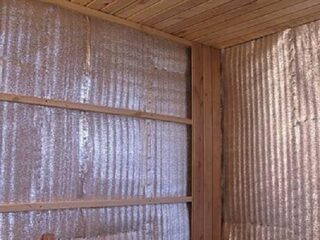
The step-by-step instructions for warming are simple, but the functionality of the entire bath complex depends on the choice of material and design.
- Work begins with waterproofing the walls. Condensation forms when hot air comes into contact with a cold surface. This leads to decay and destruction of the walls. For waterproofing in a bath, it is better to take foil-clad materials - they reflect infrared radiation back into the room.
- It is recommended to place the next layer of ordinary clean paper, secured with a large overlap - this will also help keep the hot air inside.
- At the next stage, a crate is placed from a bar with a section of 50 * 50 mm, and a heater is fixed in the cells of the frame. For the steam room use mineral, basalt wool, plate material.
- The insulation is covered with a vapor barrier. Better to take foil.
- The steam room in the bath is decorated with hardwood.
The scheme of using the steam room and sauna is the same.
Electrical wiring and lighting
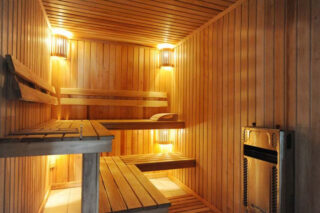
To illuminate the bath, it is required to lay electrical wiring. If the steam room is heated with an electric heater, a more powerful cable will be needed.
The installation diagrams are standard, but there are a number of installation rules for the bath complex.
- It is advised to make the wiring from the flap in one piece - this way they reduce electrical losses.
- In a wooden bath, wires are laid directly on the walls. It is forbidden to place them inside PVC pipes.
- In a brick building, cables are hidden in the walls under a layer of plaster.
- All wires are installed strictly vertically or horizontally. Kinks and kinks are excluded.
- Do not place cables in front of doors, closer than 50 cm from batteries or stove.
- The sockets cannot be installed in the steam room or sauna - only in the dressing room.
- The wires must not be placed in metal protective covers or fixed above the oven.
- Connect the wires by welding or soldering.
The lamps in the bath are chosen according to the indicators of water and dust resistance.
Ventilation organization
Ventilation should provide air renewal in the steam room 3 times per hour. This is easy to do. The inlet of the inflow is placed 120 cm from the floor, the outlet of the hood is located under the very ceiling, as high as possible. The distance between the holes must be at least 1 m.
The outlets of the supply and exhaust air are connected with a ventilation duct and lead out into the general ventilation of the bath or directly into the pipe on the roof.
Washroom finishing
You can cover the sink with different materials.
- The floors in the shower room, even in a wooden bath, are best finished with tiles or stone. The used water must drain into the drain. Therefore, the floor surface is made with a slope and from materials that are maximally water-repellent. The tree is not good. However, it is possible to arrange a slatted timber floor on a concrete base.
- The best idea for wall cladding is ceramic tiles: terracotta, majolica, double fired. Choose low-porosity ceramics or tiles with a glazed surface.
- The design of the sink, decorated with mosaics, is interesting. This method is used in spacious rooms, combined with a mini-pool. Mosaic in its qualities does not differ from ceramics, but its installation takes much longer.
- In small washrooms, lining can also be used. The material is impregnated with water-repellent and antiseptic compounds, varnished or even painted to extend the service life, but you need to be prepared for the fact that the finish from the lining will have to be changed pretty soon.
- The ceiling requirements are much simpler. Plastic panels or plates are quite suitable for finishing. For lining the ceiling, you can take lining - plastic, wood, and boards.
- If the steam room can do without a window, then in the washing room it is necessary. If possible, the window should be located on the sunny side and occupy at least 50% of the floor area in the room.
The requirements for the doors in the bath complex are the same for all premises. The dimensions of the opening are minimal - no more than 90, and preferably 80 cm, the most dense vestibule. Only such doors prevent heat leakage.
Bath furniture
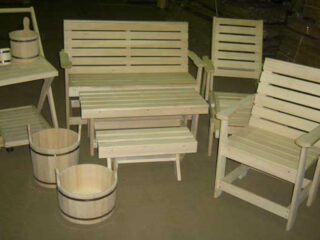
This category includes shelves, tubs, wooden sinks, as well as all other furniture in the dressing room and rest room: chairs, sofas, tables, benches. The requirements for them are somewhat different.
The sauna benches are made of the same wood as the interior decoration of the sauna. This is important, since different breeds have different levels of heat transfer. It is recommended to avoid metal fasteners during installation, as they get very hot, and use wooden chops.









